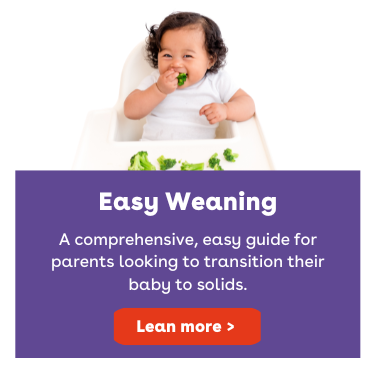Kids Eat in Color provides evidence-based feeding and nutrition tools to families with babies, toddlers and kids. In January 2023, the American Academy of Pediatrics (AAP) released the Clinical Practice Guideline for the Evaluation and Treatment of Children and Adolescents With Obesity (CPG).
This article is a breakdown of the CPG and addresses questions that parents submitted to us. These questions have been answered based on information available to us at this time. If additional information becomes available, this section will be updated.
Kids Eat in Color has also issued a position statement in response to the CPG. We have also created tools for families to use, including a guide for successful health-focused medical visits, healthy diet and eating recommendations, and how parents can focus on their child’s health instead of weight.
Here are the questions answered in this article:
What is a Clinical Practice Guideline?
Clinical Practice Guidelines (CPG) provide a “very recommended” course of action to guide physicians and medical providers in decision-making.
Physicians do not have to use the guideline, but if they do not, there should be good reasoning.
What does this CPG assume?
This CPG is based on several assumptions:
- High weight is a chronic disease by itself and should be treated by decreasing weight and/or body mass index (BMI).
- The goal of treatment is weight loss or a decrease in BMI, AND reduction or elimination of health conditions if present. (CPG pg. 5)
- Weight loss or a decrease in BMI early in life will lead to better long-term health.
Not all groups agree with all of these assumptions.
Many argue that weight is a symptom, not a disease, or that it is a risk factor for disease, but not a disease in and of itself.
The CPG notes that psychosocial and emotional problems can lead to some of the same physical symptoms associated with high weight via weight gain (CPG pg. 20).
Other groups point out the relationship between large adipose cells and all the other factors in a person’s life are very complex. Focusing on weight loss or decrease in BMI as the main goal is simplifying the problem, not providing a sustainable solution and putting a person at serious risk of harm. (1)
What are the possible conflicts of interest or biases in the CPG?
To many people on the outside, conflicts of interest do seem to exist in the CPG.
What is a conflict of interest?
A conflict of interest is when someone could receive a benefit as a result of a recommendation they have made.
For example, if an avocado grower does a research study, they may benefit. If the study says avocados are good, more avocados will sell and the grower will benefit. If the study says avocados are bad, less will sell, and the grower will be financially hurt.
So there is a conflict of interest between the grower and the research. The grower is much more likely to put out research that says avocados are good.
Conflicts of interest don’t mean that there is nothing good in the results, but it does mean the results need to be considered with potential conflicts and biases. The recommendations may be biased and useful, or biased and harmful.
Understanding all possible conflicts of interest is important.
Conflicts of interest that are mentioned in the CPG
The CPG lists one conflict of interest.
One of the authors is a co-investigator at a research center where they enroll children into their programs. The author disclosed that they have a competing financial relationship with this research center. (CPG pg. 73)
According to the CPG, the authors were all screened for conflicts of interest by the AAP. According to the CPG, none of the authors had conflicts of interest or they were “resolved through a process approved by the board of directors.” (CPG pg. 73)
Red flags for possible conflicts of interest related to professional or research services
There are 14 CPG authors. Some of them are practitioners and investigators. They may benefit when they provide services to children or conduct research studies related to child weight.
Since the CPG recommends these services, it seems there could be a conflict of interest.
Red flags for possible conflicts of interest or risk of bias related to medication recommendations
Pharmaceutical companies have significant financial interest in selling new weight loss medications. The recommendation to start children on medications early in life is desirable from a profit standpoint.
There is open-source information on the financial relationships of each CPG author. Several of the authors have benefited from interactions with pharmaceutical companies in the past through things like educational programs or paid consulting. This seems like a conflict of interest or risk of bias.
Red flag for bias due to curious medication recommendations in the CPG
In the Use of Pharmacotherapy section, it mentions that new medications were developed after the technical report (TR) was completed. (CPG starting pg. 60) It also mentions that the data about them is so good that the medications were included in the CPG. (CPG pg. 61)
In the section of glucagon-like peptide-1 receptor agonists, four of these new medications are listed:
- Liraglutide.
- Exenatide.
- Semaglutide.
- Dulaglutide.
Exenatide and liraglutide are thoroughly summarized on pages 61 and 62. The summary includes:
- Use.
- Studies.
- Side effects.
- References for the information.
For delaglutide and semaglutide, there is no information provided at all.
This is very curious given the extensive referencing and evidence used to backup all other information in the entire CPG. From an outsider perspective, it seems like there is little data at this time to support the use of these pharmacologic therapies that have potential adverse side effects.
Potential red flag for bias due to donor relationships to AAP
Some of the drug companies that make new weight loss drugs are significant donors to the AAP.
Significant funding provided by these companies could bias the organization as it reviews conflicts of interest or develops policies.
Outsider perspective on conflicts of interest
It is unclear from our external perspective why all of these items are not listed as conflicts of interest. It is possible that they are not, in fact, conflicts of interest.
The fact that they are not transparently discussed, however, makes the red flags seem more significant.
We did not attempt to contact the AAP board that manages conflicts of interest to learn more about this process or why these red flags are not considered a conflict of interest or bias.
What information was missing when the CPG was written?
The technical report lists 5 “gaps in the field.” A gap in the field is information that is important to have, but that is not available yet:
1. Systems context for interventions: It’s unclear how to exactly make these treatments work in real life, as opposed to in studies.
2. It is unknown if these treatments cause harm, but it is possible that they do. “Most studies provided no or very limited assessment of harms or unintended consequences… restrictive dieting is known to lead to disordered eating patterns, is associated with adult obesity, and may worsen the quality of a child’s food intake. Likewise, short-term weight loss has been shown to lead to weight regain above the initial weight, making it less clear whether a short period of weight loss adds more benefit than likely common weight regain… Little is known about the psychological effects on children of increasing their awareness of their own condition of obesity.” (CPG pg. 69)
3. The economics of the interventions were rarely considered: Currently many insurance payers are not paying for these services. Many hospitals that have multidisciplinary weight management programs cooperate at a loss (they lose money). There is currently no universal coverage for widespread Intensive Health and Behavior Lifestyle Treatment (IHBLT) programs and participation.
4. The current research doesn’t take many factors into account. Most studies considered biological sex, age, race, and ethnicity. The studies did not, however, consider geographical region, food insecurity, poverty or adverse childhood experiences. (TR pg. 70)
5. The interventions included limited feedback from children, families and caregivers who participated in the programs.
Will the CPG cause more bullying?
It is possible that there will be increased trauma in medical settings. Some providers may take this CPG as permission to encourage families to try weight loss or another treatment option that the family would otherwise not have chosen.
One of the goals of the CPG is to decrease stigma and bias, however, medical providers are not yet well-equipped with training on how to approach overweight and obesity diagnoses in a sensitive, health-focused manner.
The CPG states, however, it IS possible that certain racial and ethnic (and other) groups will be stigmatized more. Here’s why:
Certain groups of people have more factors that make health worse. So they will have less “success” in treatments. Those people will be compared to people with less factors that make health worse. Then they may be blamed for their poor success. Bias and stigma might increase. (CPG pg. 3)
The CPG thoroughly discusses most if not all of the factors that affect weight
The CPG states the goal is to decrease stigma and bias in the medical community by showing that weight is not an individual choice.
High weights are the consequence of many different factors affecting a person, although there are some lifestyle practices that can be helpful.
At the same time, the CPG has a weight-focused goal and recommends direct communication with the patient and family about their weight.
The effect of talking to a child and family about weight may help or harm
If a child doesn’t know that they have a weight diagnosis, a child may become more unhappy about their body when a provider talks to them about their weight.
If a child becomes more unhappy about their weight, they (or their parents) may put themselves on a diet. This could contribute to eating disorders or make them more unhealthy.
If a child is aware that they have a weight diagnosis, then the way in which a provider discusses their health will either help or harm them.
The CPG notes that a family should have a “safe space” to discuss weight and that the medical practitioner must have tact, empathy and humility. (CPG pg. 5)
If the conversation stigmatizes the child more, they may not come back for further care. (CPG pg. 27) If the conversation is provided with tact, empathy and care, it could lead to ongoing positive health-focused treatment.
Does the CPG address weight stigma and what causes higher weights?
One of the clear priorities of the CPG is to decrease and eliminate weight stigma in the medical community. This is done by explaining all of the things that affect weight.
There is stigma and bias against people with high weights
The CPG states that high weight is “long stigmatized as a reversible consequence of personal choices.” (CPG pg. 2)
This means that now and in the past, people believe that if someone is at a high weight, it is their personal choice. So, a person with higher weight should be blamed for their weight and any health problems.
People with higher weights are often treated poorly in the medical system and given poor medical care.
Many factors affect weight; most are not in a child’s control
The CPG provides a very thorough description of the factors that affect a child’s health and weight. The CPG describes a holistic perspective on child health, even though it focuses on weight.
Higher weights are related to socio-ecological, environmental and genetic influences. (CPG pg. 3)
High weight is also related to system factors like racism and individual factors like genes. They are more common in children that:
- Live in poverty.
- Live in low-resource communities.
- Come from immigrant families.
- Have experienced discrimination or stigma.
Some children have a greater chance of having a higher weight
Some children are more likely to have higher weights than other children because the risk factors for higher weights are a daily part of their lives.
For example, a child’s immune system, metabolism and even genetic expression can change if a child is exposed to bad experiences, such as food insecurity or racism. These changes can lead to changes to their energy regulation and weight. (CPG pg. 3)
The CPG describes factor after factor that affect weight. All of the pages together show how little control children have over their weight.
What treatment does the CPG recommend?
This section is based on Appendix 1 Algorithm for Screening, Diagnosis, Evaluation, and Treatment of Children and Adolescents with Obesity. Terminology used by the document is used in this section.
Screening
Providers should screen all patients:
- Measure height and weight, calculate BMI and assess BMI percentile* using CDC growth charts.
- The results should be discussed with the patient and family.
Diagnosis
Based on screening, providers should diagnose patients as follows:
- *BMI <85th percentile = do not diagnose, screen every year
- *BMI ≧85th to <95th percentile = overweight
- *BMI ≧95th percentile = obesity
- *BMI ≧120th of the 95th percentile = severe obesity
Evaluation
If the child is diagnosed, providers should evaluate the health of the child with more tests. The tests could measure things like:
- Blood pressure.
- Cholesterol.
- Liver function.
- And/or many others.
Additionally, the child should be evaluated for:
- Mental health.
- Bullying.
- Food security.
- Many other factors.
Treatment
Once a child has been evaluated, providers should** treat both a child’s weight and other health conditions at the same time.
All treatment should include:
- Intensive long-term treatment.
- Watching for additional health conditions.
- Addressing social drivers of health.
- Non-stigmatizing approaches.
- Treatment that is tailored to the child over time.
- Screening for food security and food assistance. (CPG pg. 5, 11)
Core treatment
Motivational interviewing (MI) should** be used to help a provider learn what the health goals are of families and help develop a treatment plan with them. MI should be used for all children ages 2-18 with diagnosis of overweight or obesity.
Intensive Health Behavior and Lifestyle Treatment (IHBLT) should** be used for all children ages 6 years and up with a weight diagnosis. IHBLT may** be used for children ages 2-5 diagnosed with a weight diagnosis. An IHBLT is 3-12 months of a program including at least 26 hours of time covering diet, lifestyle and behavior change (ideally face-to-face). (CPG pg. 6)
Additional treatments
Weight loss medications should** be used in addition to IHBLT for children ages 12 and up who are diagnosed with obesity.
Children ages 13 and up who are diagnosed with severe obesity (in addition to IHBLT and medications) should** be referred to Pediatric Metabolic & Bariatric Surgery programs for evaluation. Eligibility criteria for surgery include:
- BMI ≧120% of 95th percentile* with clinically significant disease (such as hypertension, type 2 diabetes, etc.)
- BMI ≧140% of 95th percentile*
**A note about “should” versus “may” language in appendix 1
According to the author interviewed, “should” does not mean that a provider must recommend a treatment. It means essentially that a provider should have this tool in their toolbox. A provider never has to recommend a specific course of action, but has different tools to choose from as a child gets older.
According to the author, “should” is a word that reflects the evidence related to the recommendation.
They acknowledged that this is unclear to any reader and may cause confusion. They intend to communicate this potential confusion back to the committee for discussion.
Why is BMI being used?
The CPG states that BMI is being used because it is:
- Frequently used.
- Easy to use.
- Has been used in studies to measure the results of programs.
The authors also acknowledge the limitations of the BMI measure. (CPG pg. 13)
At what age should BMI screening start according to the CPG?
The CPG recommends screening using BMI as the measure starting at age 2 years old (appendix 1).
The CPG states that there is no reason to delay screening, evaluation or treatment, and recommends beginning as early as possible. (CPG pg. 3, 12).
Why does the CPG recommend weight loss surgery and what percentage of children could be affected?
Young children are being diagnosed with hypertension, type 2 diabetes, non-alcoholic fatty liver disease and other chronic illnesses that used to primarily be seen in adults.
Whether weight loss surgery is the right solution to the problem is a different question.
Kids Eat in Color position on surgery
The Kids Eat in Color position is that there is not enough data to recommend weight loss surgery for children on a large scale. Focusing on health, rather than weight, can provide a strong foundation for a child to thrive.
We do understand the great health burden that children are facing. We do not support, however, the widespread recommendations for referrals for evaluation for bariatric surgery for children.
That said, individual families will explore the options for their family and that may include surgery.
Kids Eat in Color fully supports families and the complex decisions that they make.
Children who may be eligible for a surgery evaluation referral based on the CPG
Children who might be eligible for surgery must have a disease or have a high risk of disease, such as:
- Hypertension.
- Hyperlipidemia.
- Insulin resistance.
- Type 2 diabetes.
- Non-alcoholic fatty liver disease.
- Gastroesophageal reflux disease.
Risks of bariatric surgery
Bariatric surgery carries risks. The two procedures commonly used and mentioned in the CPG are laparoscopic Roux-en-Y gastric bypass and vertical sleeve gastrectomy. These are both irreversible. The CPG notes that laparoscopic adjustable gastric band procedures are only approved for patients 18 years and older. (CPG pg. 63)
Major complications within 30 days of the procedure are reported in 8% of individuals. Related procedures may be required in 13-25% of patients within five years. Bariatric surgery can cause malnutrition afterwards if a careful diet is not followed. The child will be impacted by the surgery for the rest of their life. (pg. 63)
It is also difficult to determine who will achieve their definition of “success.”
CPG position on surgery
The CPG does argue that since children have hypertension, type 2 diabetes, non-alcoholic fatty liver disease and other chronic illnesses, surgery is a good option for patients diagnosed with severe obesity.
The CPG authors conclude that there is enough data to show that surgery will improve the health of children enough to risk the possible harms.
What percentage of children could be affected by the surgery recommendation?
Although not mentioned in the CPG, here are the statistics (through 2016) for percentages of children that could qualify for a referral to be evaluated for surgery (should a pediatrician and family choose to do so):
- 7.5% of 12-15 year olds and 9.5% of 16-19 year olds fall into the BMI 120-139% of the 95th percentile* category (1). In this category, a child could be referred for surgery if they were 13 and also had another clinically significant disease.
- 2.2% of 12-15 year olds and 4.5% of 16-19 year olds fall into the BMI 140% of 95th percentile* category (1). In this category, a child could potentially be referred for surgery as long as they are 13.
According to the author that was interviewed, this doesn’t mean that all children would be referred, but only the children for which they believe it is a good option.
Additionally, many children who are referred for evaluation do not meet the eligibility criteria for surgery.
The author did mention that they hope that the CPG increases access to surgery for those children who would benefit, thereby increasing the number of surgeries performed.
Did the CPG committee look at several studies?
The CPG is based on a thorough review of weight-focused interventions published through 2020. This review is in its own technical report.
An “intervention” is a thing done to change a person’s weight. It could be a program, medical treatment or something else.
Studies
The committee read 126 lifestyle and diet randomized controlled trials, 27 medication trials and 11 surgical studies (not all trials), plus 51 observational studies. And, more studies on conditions that often happen in people with high weight. (TR figure 1)
Studies must have had the goal of reducing BMI or weight
If the goal of a lifestyle and diet study was not lower weight, then it was not included. This is because this CPG is specifically about treating high weight.
This CPG only focuses on weight. There are additional CPGs for other health conditions. So, the focus on weight is justified by assuming it will improve health. The focus on weight means that they must exclude studies focused only on health outcomes.
Additionally, only studies with a clinical component were included (so if it was just a school-based program, it was not included).
Useful interventions may have been missed because of the focus of the CPG
This is an important point. There is research that suggests people at higher weight can focus on their health and experience health benefits without focusing on their weight.
Some of the interventions in this CPG carry significant risk of side effects and other long-term effects.
If there are health-focused interventions that have the same or similar benefits to weight loss programs, then it would be good to know about them and make them available to families.
Did the CPG committee consult registered dietitians?
The CPG is written for physicians and “pediatric health care providers” that include “registered dietitians, psychologists, nurses, exercise specialists and social workers.” (CPG pg. 3)
The CPG does not include specific dietary advice for all children, just as it does not include specific medication recommendations for all children.
We do not see the need for registered dietitians to have been consulted specifically for the writing of this document.
Does this CPG change anything about schools?
No. This CPG only helps guide medical providers’ decision-making in the clinical setting.
The CPG does mention the importance of the school environment, but it is not a policy document. According to the interviewed author, there are plans for future policy recommendations.
* The CPG recommends using the CDC 2000 growth charts. These are based on data collected from the 1960s through 1990s. They are no longer representative of the population, which is why more than 5% of the population can be over the 95th percentile.
How BMI categories above the 95th percentile are calculated:
The BMI diagnostic category for “obesity” starts at the 95th percentile. From there, all other diagnostic categories are calculated.
For example, the 95th percentile is 100 pounds for the child’s weight and biological sex.
120% of 95th is 120 lbs for the same child.
References
https://publications.aap.org/pediatrics/article/141/3/e20173459/37596/Prevalence-of-Obesity-and-Severe-Obesity-in-US?autologincheck=redirected












Kids Eat in Color provides evidence-based feeding and nutrition tools to families with babies, toddlers and kids. In January 2023, the American Academy of Pediatrics (AAP) released the Clinical Practice Guideline for the Evaluation and Treatment of Children and Adolescents With Obesity (CPG).
This article is a breakdown of the CPG and addresses questions that parents submitted to us. These questions have been answered based on information available to us at this time. If additional information becomes available, this section will be updated.
Kids Eat in Color has also issued a position statement in response to the CPG. We have also created tools for families to use, including a guide for successful health-focused medical visits, healthy diet and eating recommendations, and how parents can focus on their child’s health instead of weight.
Here are the questions answered in this article:
What is a Clinical Practice Guideline?
Clinical Practice Guidelines (CPG) provide a “very recommended” course of action to guide physicians and medical providers in decision-making.
Physicians do not have to use the guideline, but if they do not, there should be good reasoning.
What does this CPG assume?
This CPG is based on several assumptions:
Not all groups agree with all of these assumptions.
Many argue that weight is a symptom, not a disease, or that it is a risk factor for disease, but not a disease in and of itself.
The CPG notes that psychosocial and emotional problems can lead to some of the same physical symptoms associated with high weight via weight gain (CPG pg. 20).
Other groups point out the relationship between large adipose cells and all the other factors in a person’s life are very complex. Focusing on weight loss or decrease in BMI as the main goal is simplifying the problem, not providing a sustainable solution and putting a person at serious risk of harm. (1)
What are the possible conflicts of interest or biases in the CPG?
To many people on the outside, conflicts of interest do seem to exist in the CPG.
What is a conflict of interest?
A conflict of interest is when someone could receive a benefit as a result of a recommendation they have made.
For example, if an avocado grower does a research study, they may benefit. If the study says avocados are good, more avocados will sell and the grower will benefit. If the study says avocados are bad, less will sell, and the grower will be financially hurt.
So there is a conflict of interest between the grower and the research. The grower is much more likely to put out research that says avocados are good.
Conflicts of interest don’t mean that there is nothing good in the results, but it does mean the results need to be considered with potential conflicts and biases. The recommendations may be biased and useful, or biased and harmful.
Understanding all possible conflicts of interest is important.
Conflicts of interest that are mentioned in the CPG
The CPG lists one conflict of interest.
One of the authors is a co-investigator at a research center where they enroll children into their programs. The author disclosed that they have a competing financial relationship with this research center. (CPG pg. 73)
According to the CPG, the authors were all screened for conflicts of interest by the AAP. According to the CPG, none of the authors had conflicts of interest or they were “resolved through a process approved by the board of directors.” (CPG pg. 73)
Red flags for possible conflicts of interest related to professional or research services
There are 14 CPG authors. Some of them are practitioners and investigators. They may benefit when they provide services to children or conduct research studies related to child weight.
Since the CPG recommends these services, it seems there could be a conflict of interest.
Red flags for possible conflicts of interest or risk of bias related to medication recommendations
Pharmaceutical companies have significant financial interest in selling new weight loss medications. The recommendation to start children on medications early in life is desirable from a profit standpoint.
There is open-source information on the financial relationships of each CPG author. Several of the authors have benefited from interactions with pharmaceutical companies in the past through things like educational programs or paid consulting. This seems like a conflict of interest or risk of bias.
Red flag for bias due to curious medication recommendations in the CPG
In the Use of Pharmacotherapy section, it mentions that new medications were developed after the technical report (TR) was completed. (CPG starting pg. 60) It also mentions that the data about them is so good that the medications were included in the CPG. (CPG pg. 61)
In the section of glucagon-like peptide-1 receptor agonists, four of these new medications are listed:
Exenatide and liraglutide are thoroughly summarized on pages 61 and 62. The summary includes:
For delaglutide and semaglutide, there is no information provided at all.
This is very curious given the extensive referencing and evidence used to backup all other information in the entire CPG. From an outsider perspective, it seems like there is little data at this time to support the use of these pharmacologic therapies that have potential adverse side effects.
Potential red flag for bias due to donor relationships to AAP
Some of the drug companies that make new weight loss drugs are significant donors to the AAP.
Significant funding provided by these companies could bias the organization as it reviews conflicts of interest or develops policies.
Outsider perspective on conflicts of interest
It is unclear from our external perspective why all of these items are not listed as conflicts of interest. It is possible that they are not, in fact, conflicts of interest.
The fact that they are not transparently discussed, however, makes the red flags seem more significant.
We did not attempt to contact the AAP board that manages conflicts of interest to learn more about this process or why these red flags are not considered a conflict of interest or bias.
What information was missing when the CPG was written?
The technical report lists 5 “gaps in the field.” A gap in the field is information that is important to have, but that is not available yet:
1. Systems context for interventions: It’s unclear how to exactly make these treatments work in real life, as opposed to in studies.
2. It is unknown if these treatments cause harm, but it is possible that they do. “Most studies provided no or very limited assessment of harms or unintended consequences… restrictive dieting is known to lead to disordered eating patterns, is associated with adult obesity, and may worsen the quality of a child’s food intake. Likewise, short-term weight loss has been shown to lead to weight regain above the initial weight, making it less clear whether a short period of weight loss adds more benefit than likely common weight regain… Little is known about the psychological effects on children of increasing their awareness of their own condition of obesity.” (CPG pg. 69)
3. The economics of the interventions were rarely considered: Currently many insurance payers are not paying for these services. Many hospitals that have multidisciplinary weight management programs cooperate at a loss (they lose money). There is currently no universal coverage for widespread Intensive Health and Behavior Lifestyle Treatment (IHBLT) programs and participation.
4. The current research doesn’t take many factors into account. Most studies considered biological sex, age, race, and ethnicity. The studies did not, however, consider geographical region, food insecurity, poverty or adverse childhood experiences. (TR pg. 70)
5. The interventions included limited feedback from children, families and caregivers who participated in the programs.
Will the CPG cause more bullying?
It is possible that there will be increased trauma in medical settings. Some providers may take this CPG as permission to encourage families to try weight loss or another treatment option that the family would otherwise not have chosen.
One of the goals of the CPG is to decrease stigma and bias, however, medical providers are not yet well-equipped with training on how to approach overweight and obesity diagnoses in a sensitive, health-focused manner.
The CPG states, however, it IS possible that certain racial and ethnic (and other) groups will be stigmatized more. Here’s why:
Certain groups of people have more factors that make health worse. So they will have less “success” in treatments. Those people will be compared to people with less factors that make health worse. Then they may be blamed for their poor success. Bias and stigma might increase. (CPG pg. 3)
The CPG thoroughly discusses most if not all of the factors that affect weight
The CPG states the goal is to decrease stigma and bias in the medical community by showing that weight is not an individual choice.
High weights are the consequence of many different factors affecting a person, although there are some lifestyle practices that can be helpful.
At the same time, the CPG has a weight-focused goal and recommends direct communication with the patient and family about their weight.
The effect of talking to a child and family about weight may help or harm
If a child doesn’t know that they have a weight diagnosis, a child may become more unhappy about their body when a provider talks to them about their weight.
If a child becomes more unhappy about their weight, they (or their parents) may put themselves on a diet. This could contribute to eating disorders or make them more unhealthy.
If a child is aware that they have a weight diagnosis, then the way in which a provider discusses their health will either help or harm them.
The CPG notes that a family should have a “safe space” to discuss weight and that the medical practitioner must have tact, empathy and humility. (CPG pg. 5)
If the conversation stigmatizes the child more, they may not come back for further care. (CPG pg. 27) If the conversation is provided with tact, empathy and care, it could lead to ongoing positive health-focused treatment.
Does the CPG address weight stigma and what causes higher weights?
One of the clear priorities of the CPG is to decrease and eliminate weight stigma in the medical community. This is done by explaining all of the things that affect weight.
There is stigma and bias against people with high weights
The CPG states that high weight is “long stigmatized as a reversible consequence of personal choices.” (CPG pg. 2)
This means that now and in the past, people believe that if someone is at a high weight, it is their personal choice. So, a person with higher weight should be blamed for their weight and any health problems.
People with higher weights are often treated poorly in the medical system and given poor medical care.
Many factors affect weight; most are not in a child’s control
The CPG provides a very thorough description of the factors that affect a child’s health and weight. The CPG describes a holistic perspective on child health, even though it focuses on weight.
Higher weights are related to socio-ecological, environmental and genetic influences. (CPG pg. 3)
High weight is also related to system factors like racism and individual factors like genes. They are more common in children that:
Some children have a greater chance of having a higher weight
Some children are more likely to have higher weights than other children because the risk factors for higher weights are a daily part of their lives.
For example, a child’s immune system, metabolism and even genetic expression can change if a child is exposed to bad experiences, such as food insecurity or racism. These changes can lead to changes to their energy regulation and weight. (CPG pg. 3)
The CPG describes factor after factor that affect weight. All of the pages together show how little control children have over their weight.
What treatment does the CPG recommend?
This section is based on Appendix 1 Algorithm for Screening, Diagnosis, Evaluation, and Treatment of Children and Adolescents with Obesity. Terminology used by the document is used in this section.
Screening
Providers should screen all patients:
Diagnosis
Based on screening, providers should diagnose patients as follows:
Evaluation
If the child is diagnosed, providers should evaluate the health of the child with more tests. The tests could measure things like:
Additionally, the child should be evaluated for:
Treatment
Once a child has been evaluated, providers should** treat both a child’s weight and other health conditions at the same time.
All treatment should include:
Core treatment
Motivational interviewing (MI) should** be used to help a provider learn what the health goals are of families and help develop a treatment plan with them. MI should be used for all children ages 2-18 with diagnosis of overweight or obesity.
Intensive Health Behavior and Lifestyle Treatment (IHBLT) should** be used for all children ages 6 years and up with a weight diagnosis. IHBLT may** be used for children ages 2-5 diagnosed with a weight diagnosis. An IHBLT is 3-12 months of a program including at least 26 hours of time covering diet, lifestyle and behavior change (ideally face-to-face). (CPG pg. 6)
Additional treatments
Weight loss medications should** be used in addition to IHBLT for children ages 12 and up who are diagnosed with obesity.
Children ages 13 and up who are diagnosed with severe obesity (in addition to IHBLT and medications) should** be referred to Pediatric Metabolic & Bariatric Surgery programs for evaluation. Eligibility criteria for surgery include:
**A note about “should” versus “may” language in appendix 1
According to the author interviewed, “should” does not mean that a provider must recommend a treatment. It means essentially that a provider should have this tool in their toolbox. A provider never has to recommend a specific course of action, but has different tools to choose from as a child gets older.
According to the author, “should” is a word that reflects the evidence related to the recommendation.
They acknowledged that this is unclear to any reader and may cause confusion. They intend to communicate this potential confusion back to the committee for discussion.
Why is BMI being used?
The CPG states that BMI is being used because it is:
The authors also acknowledge the limitations of the BMI measure. (CPG pg. 13)
At what age should BMI screening start according to the CPG?
The CPG recommends screening using BMI as the measure starting at age 2 years old (appendix 1).
The CPG states that there is no reason to delay screening, evaluation or treatment, and recommends beginning as early as possible. (CPG pg. 3, 12).
Why does the CPG recommend weight loss surgery and what percentage of children could be affected?
Young children are being diagnosed with hypertension, type 2 diabetes, non-alcoholic fatty liver disease and other chronic illnesses that used to primarily be seen in adults.
Whether weight loss surgery is the right solution to the problem is a different question.
Kids Eat in Color position on surgery
The Kids Eat in Color position is that there is not enough data to recommend weight loss surgery for children on a large scale. Focusing on health, rather than weight, can provide a strong foundation for a child to thrive.
We do understand the great health burden that children are facing. We do not support, however, the widespread recommendations for referrals for evaluation for bariatric surgery for children.
That said, individual families will explore the options for their family and that may include surgery.
Kids Eat in Color fully supports families and the complex decisions that they make.
Children who may be eligible for a surgery evaluation referral based on the CPG
Children who might be eligible for surgery must have a disease or have a high risk of disease, such as:
Risks of bariatric surgery
Bariatric surgery carries risks. The two procedures commonly used and mentioned in the CPG are laparoscopic Roux-en-Y gastric bypass and vertical sleeve gastrectomy. These are both irreversible. The CPG notes that laparoscopic adjustable gastric band procedures are only approved for patients 18 years and older. (CPG pg. 63)
Major complications within 30 days of the procedure are reported in 8% of individuals. Related procedures may be required in 13-25% of patients within five years. Bariatric surgery can cause malnutrition afterwards if a careful diet is not followed. The child will be impacted by the surgery for the rest of their life. (pg. 63)
It is also difficult to determine who will achieve their definition of “success.”
CPG position on surgery
The CPG does argue that since children have hypertension, type 2 diabetes, non-alcoholic fatty liver disease and other chronic illnesses, surgery is a good option for patients diagnosed with severe obesity.
The CPG authors conclude that there is enough data to show that surgery will improve the health of children enough to risk the possible harms.
What percentage of children could be affected by the surgery recommendation?
Although not mentioned in the CPG, here are the statistics (through 2016) for percentages of children that could qualify for a referral to be evaluated for surgery (should a pediatrician and family choose to do so):
According to the author that was interviewed, this doesn’t mean that all children would be referred, but only the children for which they believe it is a good option.
Additionally, many children who are referred for evaluation do not meet the eligibility criteria for surgery.
The author did mention that they hope that the CPG increases access to surgery for those children who would benefit, thereby increasing the number of surgeries performed.
Did the CPG committee look at several studies?
The CPG is based on a thorough review of weight-focused interventions published through 2020. This review is in its own technical report.
An “intervention” is a thing done to change a person’s weight. It could be a program, medical treatment or something else.
Studies
The committee read 126 lifestyle and diet randomized controlled trials, 27 medication trials and 11 surgical studies (not all trials), plus 51 observational studies. And, more studies on conditions that often happen in people with high weight. (TR figure 1)
Studies must have had the goal of reducing BMI or weight
If the goal of a lifestyle and diet study was not lower weight, then it was not included. This is because this CPG is specifically about treating high weight.
This CPG only focuses on weight. There are additional CPGs for other health conditions. So, the focus on weight is justified by assuming it will improve health. The focus on weight means that they must exclude studies focused only on health outcomes.
Additionally, only studies with a clinical component were included (so if it was just a school-based program, it was not included).
Useful interventions may have been missed because of the focus of the CPG
This is an important point. There is research that suggests people at higher weight can focus on their health and experience health benefits without focusing on their weight.
Some of the interventions in this CPG carry significant risk of side effects and other long-term effects.
If there are health-focused interventions that have the same or similar benefits to weight loss programs, then it would be good to know about them and make them available to families.
Did the CPG committee consult registered dietitians?
The CPG is written for physicians and “pediatric health care providers” that include “registered dietitians, psychologists, nurses, exercise specialists and social workers.” (CPG pg. 3)
The CPG does not include specific dietary advice for all children, just as it does not include specific medication recommendations for all children.
We do not see the need for registered dietitians to have been consulted specifically for the writing of this document.
Does this CPG change anything about schools?
No. This CPG only helps guide medical providers’ decision-making in the clinical setting.
The CPG does mention the importance of the school environment, but it is not a policy document. According to the interviewed author, there are plans for future policy recommendations.
* The CPG recommends using the CDC 2000 growth charts. These are based on data collected from the 1960s through 1990s. They are no longer representative of the population, which is why more than 5% of the population can be over the 95th percentile.
How BMI categories above the 95th percentile are calculated:
The BMI diagnostic category for “obesity” starts at the 95th percentile. From there, all other diagnostic categories are calculated.
For example, the 95th percentile is 100 pounds for the child’s weight and biological sex.
120% of 95th is 120 lbs for the same child.
References
https://publications.aap.org/pediatrics/article/141/3/e20173459/37596/Prevalence-of-Obesity-and-Severe-Obesity-in-US?autologincheck=redirected